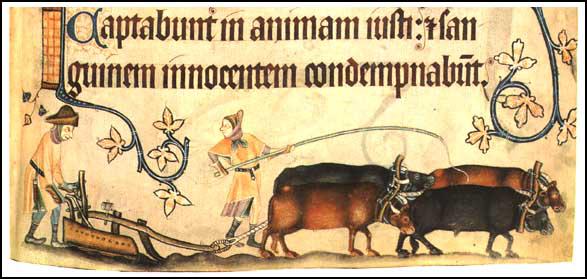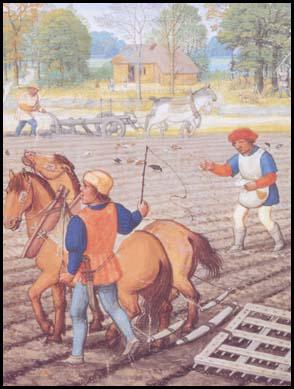Farm Animals
All the families living in Yalding own animals. Livestock includes oxen, horses, cows, pigs, sheep and chickens. Finding enough food for the animals is a constant problem for the farmers. At the end of the autumn, the villagers have to decide how many animals they can afford to keep alive during the winter.
Oxen are the most valued animals owned by the peasants as they are used to plough the land. Most plough-teams consist of between four and eight oxen. As it is unusual for villagers to own more than two oxen, it is necessary for them to combine their resources in order to have their land ploughed efficiently.
Some villagers use horses for ploughing. When the condition of the ground is good, horses are faster than oxen. However, most villagers prefer employing oxen for this task. Oxen are cheaper to keep than horses. Oxen are also more willing to work in difficult conditions.
Pigs are also popular animals to own as they have the ability to find food for themselves. Their favourite food is acorns from oak trees and nuts from beech trees. The villagers have to pay pannage to Hugh de Audley before he allows their pigs to go into the woods to search for food.
Pigs can cause a lot of damage in their search for food. Yalding, like most villages in England, has by-laws stating that all pigs have to have an iron ring placed in their nose. Gilbert Payne is Yalding's swineherd. He gathers the pigs together and takes them into the wood so that they can feed on acorns. On other occasions he takes them to feed on the waste ground. Every year the peopk living in Yalding give him a penny for every pig that he has looked after.
Pigs can produce two litters a year and each litter can number six or more piglets. Pigs are ready for eating in their second year. The meat produced by pigs is important to the peasants as the animal supplies much of the fat in their diet.

Cows are kept for their milk. Cows are expensive and in 1336 cost over 9s. to buy. The villagers also have difficulty finding enough hay for them to eat during the winter.
Most of the families obtain their milk from female sheep called ewes. At Is. 6d. ewes are fairly cheap to buy and are much easier to feed in the winter. Although a ewe only produces a tenth of the milk of a cow, they also provide wool for clothing and if necessary, meat during the winter months. Their dung also helps the crops grow.
In 1336 there are five times as many sheep as people in England. The keeping of sheep does create extra work for villagers. Sheep do a lot of damage if they manage to get into the fields growing crops. They therefore have to be herded during the day and fenced in at night. The sheep also have to be protected against predators like wolves.

1. Read Animals in Yalding. Fill in section 4 and 5 of your Family Information Chart.
2. Name the people in the village who own: (a) a bull; (b) two or more oxen; (c) at least ten cows; (d) more than a eighty sheep.
3. Explain the advantages and disadvantages of keeping sheep.
5. Look at source 1. How is the swineherd helping the pigs find food?
6. Study sources 2 and 3. (a) Give three possible reasons why the man in source 2 is using oxen rather than horses. (b) Describe the two ploughs being used in these pictures. Explain how these ploughs are different. Why did farm workers use two different types of plough?
